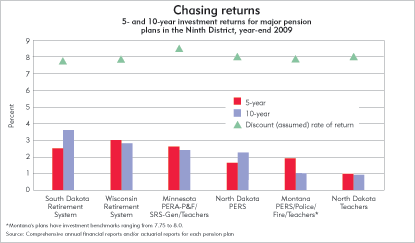
It’s hard to overstate the role of volatile stock market returns in the current status of pension plans.
Just a decade ago, and even more recently for some, a number of state and local pension plans were fully funded, thanks to the investment boom of the 1990s. The 2001 recession threw a monkey wrench into investment returns, with most plans suffering modest investment losses two years running. Although returns in the middle of the decade were strong, the recent and huge investment losses amount to more than a monkey wrench; call it a total transmission failure.
Investment return is the magic elixir that helps generally modest contributions from employers and workers grow into lifelong retirement income. From 1990 to 2009, 60 percent of pension asset gains in the Public Employees Retirement Association of Minnesota came from investment.
But the investment knife cuts both ways, and it can be deadly. In 2007, the Montana Public Employees’ Retirement System earned $629 million from investment gains—or about 82 percent of net asset gains that year (employers and workers contributed the rest). But two years later, PERS saw an investment loss of almost $800 million.
Defenders are quick to say that benchmarks are meant to be an average over time. But lean investment years at the start and end of the last decade have thrown cold water on long-term expectations. District pension plans peg investment returns between 7.75 and 8.5 percent, depending on the plan. No plan has come close to those rates over the previous decade (see chart).
Investment returns will have to do double time for a considerable period—upward of 12 percent annual gains for a decade for some plans—to achieve that rough 8 percent target. The alternative (which most plans have recently enacted or are considering) is to increase employer and worker contributions to make up lost asset growth until returns rebound to the historic trend—a realistic expectation, according to many in the industry.
“I’ve talked to a lot of actuaries,” said one source, and they say the 8 percent benchmark “has been reinforced again and again over time.”
Even if long-run rates can recover to 8 percent—hardly a given in today’s economic environment—it’s unclear if pensions can ride out any continued volatility in the short and medium run. The question is whether pensions can stay solvent longer than financial markets can remain out of kilter. Not everyone is so sure.
An actuarial experience study analyzes a pension’s assumptions for long-term accuracy. One such study last year for the North Dakota Teachers Fund for Retirement found that returns averaged about 2 percent over the last decade, and 6.6 percent over 20 years—well short of the plan’s 8 percent benchmark. It said the rates of return on equities and other assets “vary so dramatically from year to year that even a 20-year period is not long enough to provide reasonable guidance.” Over a 10- or 20-year period, the report said, there was “a significant possibility that the average return will be less than 6.5 percent or greater than 9.5 percent.”
How plans react in such an environment says a lot about how they view risk in fiduciary terms. The South Dakota and Wisconsin retirement systems both have comparatively low investment benchmarks (7.75 percent and 7.8 percent, respectively), and their returns over the last decade have outperformed district peers. But sources with both systems said they are at least considering lowering their benchmarks—despite the fact that both systems reported gains in the neighborhood of 20 percent in their most recent fiscal year.
That’s because plans still lose when a big loss is canceled out by an equally big gain. If plans discount liabilities at 8 percent annually, staying even after two volatile years puts a fund almost 17 percent behind (after the compounding effect) its return projection over this brief period.
Unfortunately, a lower benchmark is not a realistic political choice for many plans, because the sponsor is acknowledging that assets will not grow as much as previously projected, which automatically increases unfunded liabilities, pulls down the funded ratio and exposes employers (and possibly workers) to even larger contributions. The most recent actuarial valuation for the Montana Teachers Retirement System demonstrated that lowering its investment benchmark from 7.75 percent to 6.75 percent would cut its funded ratio from 65 percent to 58 percent.
As a result, some plans are forced to keep rolling the dice, using history to help rationalize more aggressive investments to hopefully pull a pension out of its financial hole. In fact, that’s what appears to have happened in response to negative investment returns during the 2001 recession.
A recent NBER working paper examined portfolio allocations and plan characteristics of 125 state pension funds from 2000 to 2009 and found that pension funds chose greater portfolio risk following periods of relatively poor investment performance. Equally important, plans with a relatively high benchmark rate “tend to choose riskier portfolios.”
Place your bets.
Ron Wirtz is a Minneapolis Fed regional outreach director. Ron tracks current business conditions, with a focus on employment and wages, construction, real estate, consumer spending, and tourism. In this role, he networks with businesses in the Bank’s six-state region and gives frequent speeches on economic conditions. Follow him on Twitter @RonWirtz.






